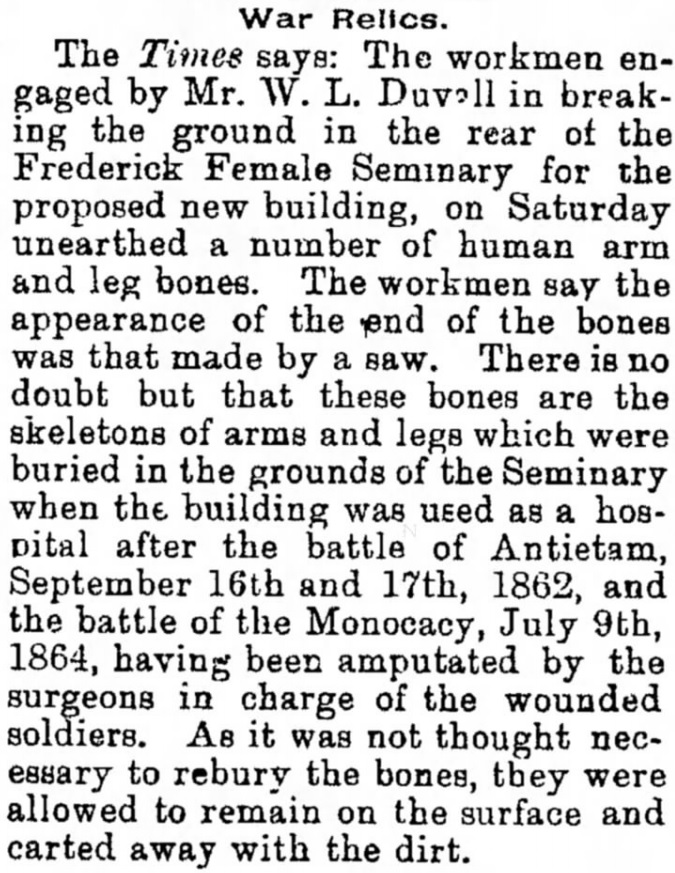Table of Contents
Buried Limbs at Winchester Hall
In late September 1862, the 8,000 residents of Frederick, Maryland witnessed firsthand the cruel nature of the American Civil War. While members of the Army of the Potomac marched through their streets to join their comrades at the front along the Antietam, hundreds of wounded were already streaming back toward the clustered spires of Frederick.
Doctor and author Oliver Wendell Holmes, Sr. described the scene as he witnessed it while desperately searching for his wounded son:
And now, as we emerged from Frederick, we struck at once upon the trail from the great battle-field. The road was filled with straggling and wounded soldiers. All who could travel on foot,— multitudes with slight wounds of the upper limbs, the head, or face, –were told to take up their beds,—alight burden or none at all,—and walk…
It was a pitiable sight, truly pitiable, yet so vast, so far beyond the possibility of relief, that many single sorrows of small dimensions have wrought upon my feelings more than the sight of this great caravan of maimed pilgrims.[1]
Close to 10,000 sick, wounded, and maimed soldiers were evacuated to the makeshift hospitals in the schools, churches, and private homes of Frederick.
The wounded and dying were quartered in 27 public buildings in Downtown Frederick. Among the most prominent structures used as a hospital were the two wings of Winchester Hall. The 1845 building was home to the Frederick Female Seminary, a boarding school for girls from across the Mid-Atlantic.

The Union Army occupied Winchester Hall from September 17, 1862 until January 17, 1863, leaving it in “a most wretched, filthy, and dilapidated condition.[2] The building’s use as a hospital for hundreds of patients threw the owner of the school, Hiram Winchester, into deep disillusionment.
He correctly surmised that the school’s use as a hospital would negatively impact his business. “My old friend still tell me they do not like to send their daughters here to sleep in the same rooms that were used for a hospital,” he wrote. The school did not reopen until after the Civil War had concluded, in 1865, and even then under new management.
The memory of the Civil War’s impact on Frederick began to recede, the years passed and put more distance between the painful moments and the present. At Winchester Hall, life returned to normal and the school prospered enough to allow for a renovation and expansion of the existing wings. An addition was planned for the southern end of the structure and construction began in the spring of 1887.
Then the building’s past usage as a hospital came into view once more. This small selection comes from Frederick’s daily, The News, published May 10, 1887.
War Relics
The workman engaged by Mr. W.L. Duvall in breaking the ground in the rear of the Frederick Female Seminary for the proposed new building, on Saturday unearthed a number of human arm and leg bones. The workmen say the appearance of the end of the bones was that made by a saw. There is no doubt but that these bones are the skeletons of arms and legs which were buried in the grounds of the Seminary when the building was used as a hospital after the Battle of Antietam…
As it was not thought necessary to rebury the bones, they were allowed to remain on the surface and carted away with the dirt.
Despite the discovery, construction continued without major stoppage. While memories from the war were still fresh, communities across the country were attempting to press forward from their bloody past. The addition was completed, and while the Frederick Female Seminary eventually closed, the building housed the first classes of the Women’s College of Frederick, which later became Hood College.
Today, Winchester Hall contains the offices of Frederick County Government. While the interior has changed drastically since the 1860s, its exterior has remained much the same as it looked during its use as a hospital in 1862-63.
For more information on Winchester Hall’s use by the Union Army during the Civil War, consult One Vast Hospital: The Civil War Hospital Sites in Frederick, Maryland after Antietam by NMCWM Research Director Terry Reimer.
A searchable database of patients treated in Frederick in the aftermath of the battles of South Mountain and Antietam is available online.
About the Author
Jake Wynn is the Program Coordinator at the National Museum of Civil War Medicine. He also writes independently at the Wynning History blog.
[1] Oliver Wendell Holmes, “My Hunt After the Captain” The Atlantic, December 1862.
[2] Hiram Winchester to the Quartermaster Department, May 1864 (NARA)




Leave a Reply
You must be logged in to post a comment.